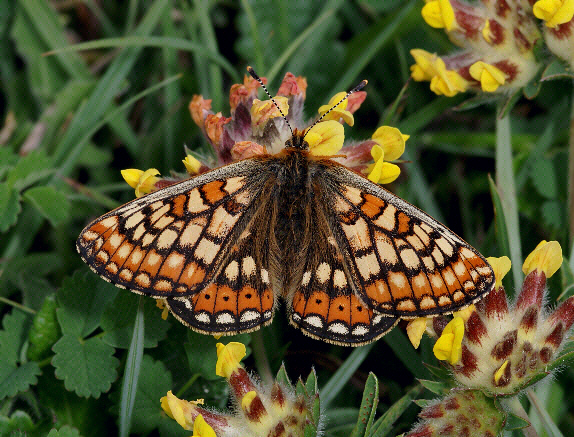 Marsh Fritillary Euphydryas aurinia, female, Dorset – Adrian Hoskins
Marsh Fritillary Euphydryas aurinia, female, Dorset – Adrian Hoskins
Introduction
The Marsh Fritillary is one of our most endangered butterflies. It is also one of our most beautiful, and one which is highly variable in its markings, which range from a unicolorous orange forms with thin grey markings, to gaudy forms patterned in orange, red and cream with heavy black markings. Within a few days of emergence, many of the wing scales get rubbed off, exposing the cuticle of the wing surface, and giving the butterfly a shiny appearance which led to it’s former name of “Greasy Fritillary”.
It occurs in localised colonies throughout most of Europe, but is absent from northern Scandinavia, peninsular Italy and the Mediterranean islands. In mountainous areas a small and more unicolorous sub-species debilis occurs, which some workers regard as being a separate species. Beyond Europe the Marsh Fritillary it occurs in Morocco, Algeria and across temperate Asia to Korea.
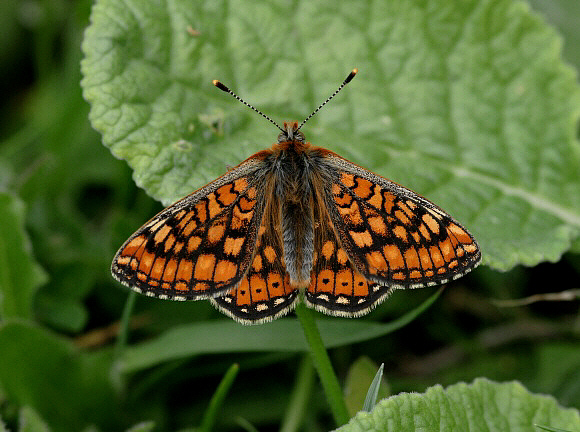 Marsh Fritillary Euphydryas aurinia, male, Dorset – Adrian Hoskins
Marsh Fritillary Euphydryas aurinia, male, Dorset – Adrian Hoskins
Habitats
In the British Isles the majority of colonies are on lightly grazed ancient calcareous grasslands, but in former times was common in boggy meadows and heaths. Although it is nowadays a rare species, it still breeds in a wide variety of other habitats including wet heathland, damp unimproved flowery meadows, disused railway cuttings, and in damp clearings and rides in woodland.
In former times, small colonies that had been lost as a result of temporary habitat degradation, climatic influence or the effects of parasitism, could be re-colonised from other populations nearby. Sadly, in the modern world former habitats have become neglected, fragmented and isolated. The butterflies are unable to recolonise from distant sites – consequently the distribution is now extremely patchy, with local extinctions occurring at a very alarming rate.
The range of the butterfly contracted during the latter half of the 20th century, and it is now extinct in the eastern counties of Britain, and increasingly rare in Scotland and northern England.
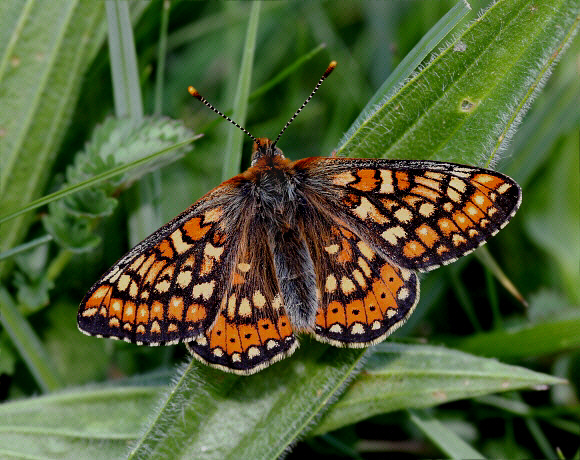 Marsh Fritillary Euphydryas aurinia, male, Cerne Abbas, Dorset – Adrian Hoskins
Marsh Fritillary Euphydryas aurinia, male, Cerne Abbas, Dorset – Adrian Hoskins
Lifecycle
The eggs are laid in May and early June, in neat heaps on the underside of leaves of devil’s bit scabious Succisa pratensis. In continental Europe a wider range of foodplants are used including Scabiosa, Lonicera, Cephalaria, Knautia, Gentiana, Primula, Digitalis and Plantago.
They are pale yellow when first laid, quickly becoming bright yellow, then turning to crimson, and finally to dark grey just prior to hatching. Usually all the eggs are laid in a single batch close to the emergence site, but in hot summers the females disperse after laying the main batch of eggs, and lay smaller batches some distance from the nucleus of the breeding site. Females will oviposit on quite small scabious plants, with leaves appressed to the ground, but greatly prefer larger plants with lush leaves raised well above the ground, growing amongst fine grasses.
Immediately after hatching, the larvae spin a fine silken web on the leaves of their foodplant. They feed during sunny weather, but retire into the web overnight or when the weather is unfavourable. They grow slowly, and go into hibernation in August or September, when they are still very small.
In early March they awaken from hibernation, and resume feeding. During the next month the black spiky larvae move from plant to plant, spinning new communal webs as and when required. When they reach the 4th instar, they become solitary, and in warm weather are often seen wandering in search of scabious plants.
When ready to pupate the fully grown larva attaches itself by the cremaster to a grass stem, often close to a bush or at the edge of a path or rabbit scrape. After about 2 days it makes the final moult to reveal the pretty pupa which is pale buff in colour, marked with black streaks on the wing cases, and orange and black spots on the abdomen.
In May 2005, at a site in Dorset, I found a pupa that was just beginning to hatch, and I was able to watch the emergence and wing-drying process, which took about an hour to complete.
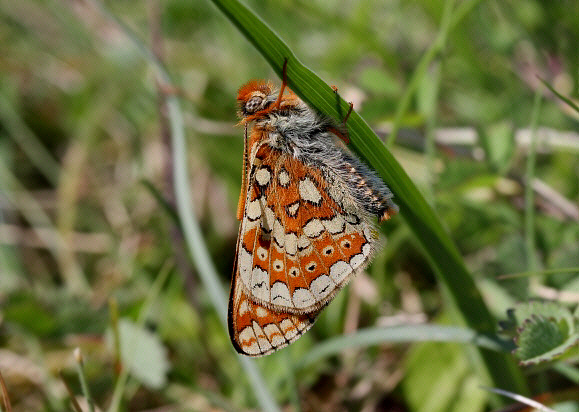 Euphydryas aurinia, freshly emerged male drying wings, Cerne Abbas, Dorset – Adrian Hoskins
Euphydryas aurinia, freshly emerged male drying wings, Cerne Abbas, Dorset – Adrian Hoskins
Adult behaviour
Females are burdened by the weight of hundreds of eggs, and fly only short distances. Males are very active on the wing, flitting rapidly, low over the ground in search of females, but stopping frequently to take nectar from a variety of flowers including buttercups, hawkbit, bugle, germander speedwell, milkworts, orchids and marsh thistle. They also appear to be attracted to certain fungi – in 1985 I found over a dozen male Marsh Fritillaries which had become glued by their wings to the sticky surface of fungi at a site in north-east Hampshire.
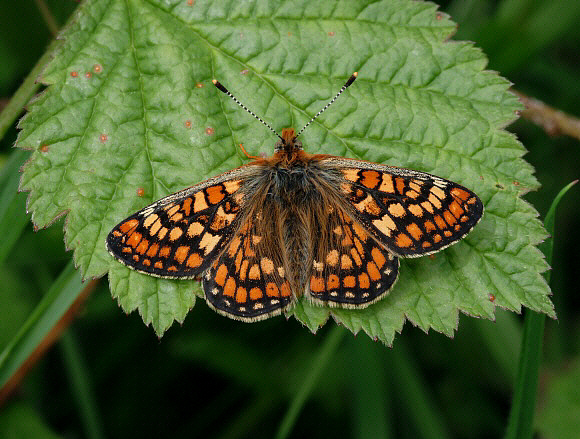
Marsh Fritillary Euphydryas aurinia, male, Dorset – Adrian Hoskins
The prenuptial process is brief, as witnessed by the following observation in late May 2009 : At noon I watched a male intercept a flying female, which immediately settled in the grass with her wings open. The male buzzed around her but made no attempt to copulate. The female then flew a very short distance, followed by the male which alighted beside her. This process was repeated 3 times until the female found a suitable blade of grass on which she settled with her wings outspread and her abdomen curved downward. The male approached from beneath and curled up his abdomen to make contact. The pair remained copulated in this position for several minutes until a gust of wind caused them to readjust, after which they crawled onto a nearby bramble leaf on which they rested with wings closed. About 2 hours later when I returned to the spot I found them basking with wings outspread. It is likely that the butterflies remain copulated overnight – I have often found copulated pairs at dusk, and on occasions when I have bred this species in captivity the pairs have always remained joined overnight and parted early the next morning.
If a male intercepts a female which has already mated, the female walks and flutters about on the ground amongst fine grasses, vibrating her open wings, whilst the male excitedly dances around her in a series of tight figure-of-eight movements. The purpose of this activity seems to be to “imprison” the female while the male showers her with pheromones, but the unreceptive female simply sits tight until the male gives up and flies away.
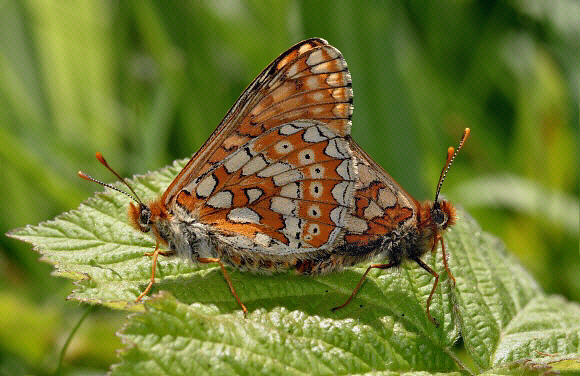
Marsh Fritillary Euphydryas aurinia, copulated pair, Dorset – Adrian Hoskins
In overcast weather conditions, butterflies of both sexes bask for long periods on low foliage, or in rabbit-scrapes or other depressions. Overnight, or in wet weather, they hide themselves deep within tussocks of grass.
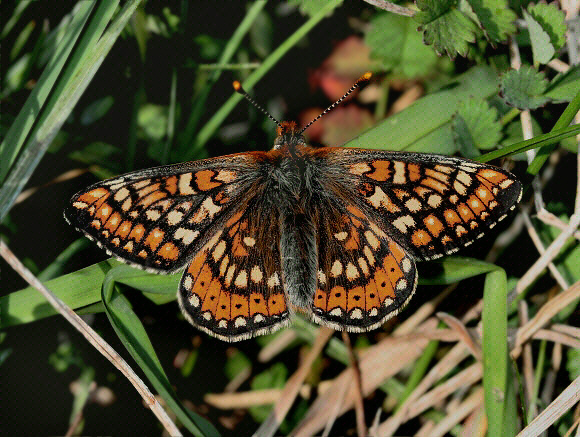
Marsh Fritillary Euphydryas aurinia, male, Cerne Abbas, Dorset – Adrian Hoskins
Population dynamics
Marsh Fritillary populations are prone to major fluctuation, directly or indirectly arising from climatic events. If the early spring is cold and sunny the overwintered larvae are able to warm themselves up by basking on dead leaves, thereby increasing their metabolism and allowing them to develop quickly. However they are highly prone to attacks by the parasitoid wasp Apanteles bignellii, which pupates in the shade among grasses and develops relatively slowly. If the adult wasps emerge too late they find that many of the larvae have beaten them to it, and already pupated. Consequently a few weeks later large numbers of Marsh Fritillaries emerge. Conversely in warmer and more humid springs the wasp pupae develop rapidly and when the adult wasps emerge they find there are still many larvae for them to attack. Accordingly survival rates of the larvae are considerably lower if the spring has been warm, and fewer butterflies emerge to breed.
A couple of successive warm springs, combined with dull or wet weather during the butterfly’s flight season can easily wipe out a small colony of butterflies. In places where several aurinia colonies exist in close proximity, the populations periodically contract or expand as a consequence of larval survival rates, but remain viable even during major contractions. Isolated colonies however are easily lost, causing a steady contraction of the butterfly’s range.
